Research Proposal for D/507/9468: Greenery Impact on Wellbeing
VerifiedAdded on 2023/04/21
|20
|4951
|257
Report
AI Summary
This report presents a research proposal and a critical appraisal of a systematic review, both centered on the effects of greenery on the physical and mental wellbeing of patients, particularly those with dementia. The research proposal investigates the behavioural and physiological impacts of visual exposure to green spaces, driven by the problem statement that mental health conditions, like anxiety and depression, are a major public health concern. The proposal outlines the research question, aim, objectives, study design (systematic review), study population, data collection methods, and ethical considerations. The critique focuses on a systematic review that explores the impact of outdoor spaces, like gardens, on the wellbeing of dementia patients. The critique evaluates the focus, background, aim, methodological approach, data collection, analysis, sample, ethical considerations, main findings, conclusions, strengths, limitations, and application to practice of the systematic review. The report highlights the importance of non-pharmacological interventions and the significance of providing appropriate environments for dementia patients, including access to gardens and green spaces.

Running head: RESEARCH ACTIVITY
Unit Reference- Number D/507/9468
Name of the Student
Name of the University
Author Note
Unit Reference- Number D/507/9468
Name of the Student
Name of the University
Author Note
Paraphrase This Document
Need a fresh take? Get an instant paraphrase of this document with our AI Paraphraser
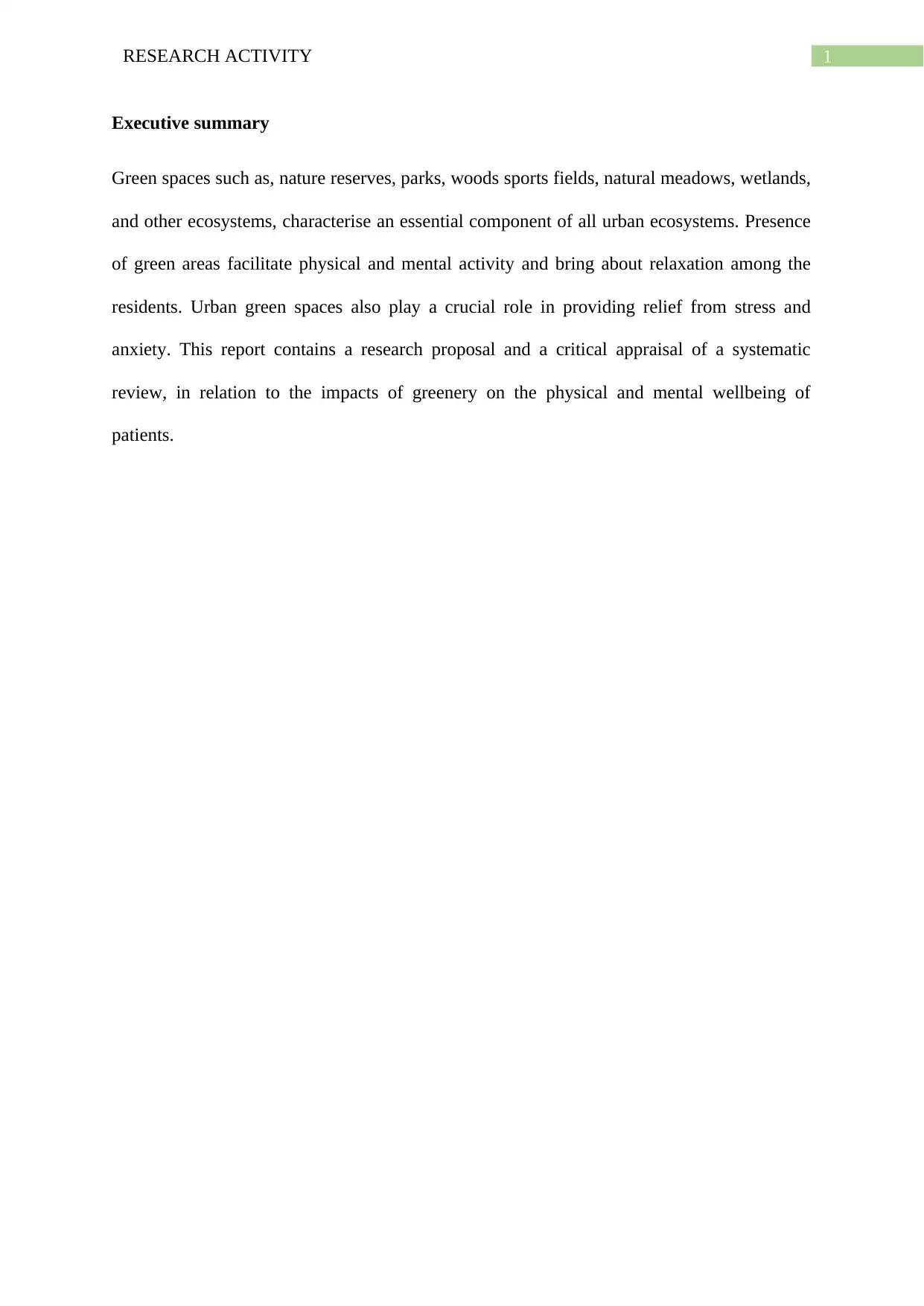
1RESEARCH ACTIVITY
Executive summary
Green spaces such as, nature reserves, parks, woods sports fields, natural meadows, wetlands,
and other ecosystems, characterise an essential component of all urban ecosystems. Presence
of green areas facilitate physical and mental activity and bring about relaxation among the
residents. Urban green spaces also play a crucial role in providing relief from stress and
anxiety. This report contains a research proposal and a critical appraisal of a systematic
review, in relation to the impacts of greenery on the physical and mental wellbeing of
patients.
Executive summary
Green spaces such as, nature reserves, parks, woods sports fields, natural meadows, wetlands,
and other ecosystems, characterise an essential component of all urban ecosystems. Presence
of green areas facilitate physical and mental activity and bring about relaxation among the
residents. Urban green spaces also play a crucial role in providing relief from stress and
anxiety. This report contains a research proposal and a critical appraisal of a systematic
review, in relation to the impacts of greenery on the physical and mental wellbeing of
patients.
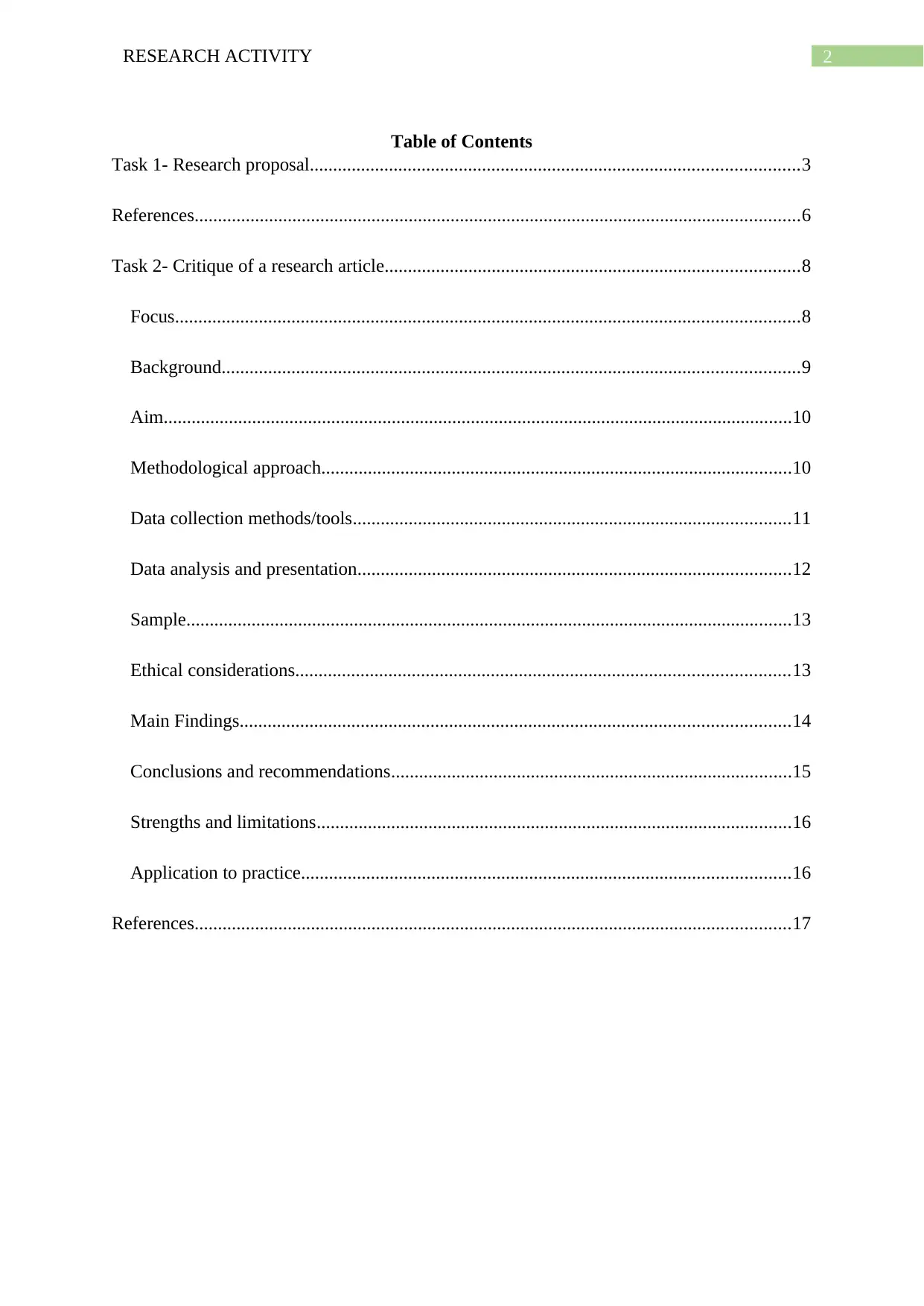
2RESEARCH ACTIVITY
Table of Contents
Task 1- Research proposal.........................................................................................................3
References..................................................................................................................................6
Task 2- Critique of a research article.........................................................................................8
Focus......................................................................................................................................8
Background............................................................................................................................9
Aim.......................................................................................................................................10
Methodological approach.....................................................................................................10
Data collection methods/tools..............................................................................................11
Data analysis and presentation.............................................................................................12
Sample..................................................................................................................................13
Ethical considerations..........................................................................................................13
Main Findings......................................................................................................................14
Conclusions and recommendations......................................................................................15
Strengths and limitations......................................................................................................16
Application to practice.........................................................................................................16
References................................................................................................................................17
Table of Contents
Task 1- Research proposal.........................................................................................................3
References..................................................................................................................................6
Task 2- Critique of a research article.........................................................................................8
Focus......................................................................................................................................8
Background............................................................................................................................9
Aim.......................................................................................................................................10
Methodological approach.....................................................................................................10
Data collection methods/tools..............................................................................................11
Data analysis and presentation.............................................................................................12
Sample..................................................................................................................................13
Ethical considerations..........................................................................................................13
Main Findings......................................................................................................................14
Conclusions and recommendations......................................................................................15
Strengths and limitations......................................................................................................16
Application to practice.........................................................................................................16
References................................................................................................................................17
⊘ This is a preview!⊘
Do you want full access?
Subscribe today to unlock all pages.

Trusted by 1+ million students worldwide
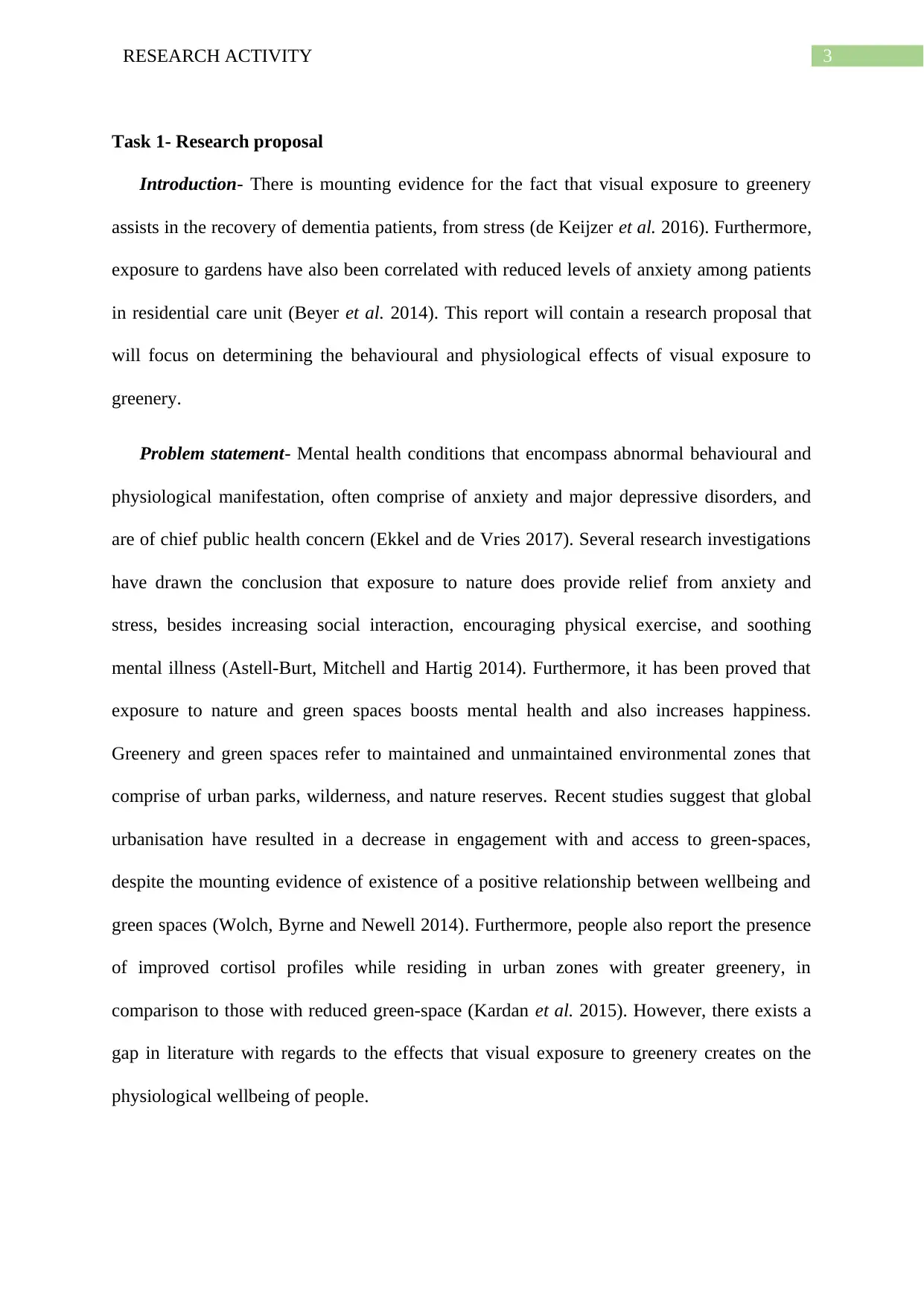
3RESEARCH ACTIVITY
Task 1- Research proposal
Introduction- There is mounting evidence for the fact that visual exposure to greenery
assists in the recovery of dementia patients, from stress (de Keijzer et al. 2016). Furthermore,
exposure to gardens have also been correlated with reduced levels of anxiety among patients
in residential care unit (Beyer et al. 2014). This report will contain a research proposal that
will focus on determining the behavioural and physiological effects of visual exposure to
greenery.
Problem statement- Mental health conditions that encompass abnormal behavioural and
physiological manifestation, often comprise of anxiety and major depressive disorders, and
are of chief public health concern (Ekkel and de Vries 2017). Several research investigations
have drawn the conclusion that exposure to nature does provide relief from anxiety and
stress, besides increasing social interaction, encouraging physical exercise, and soothing
mental illness (Astell-Burt, Mitchell and Hartig 2014). Furthermore, it has been proved that
exposure to nature and green spaces boosts mental health and also increases happiness.
Greenery and green spaces refer to maintained and unmaintained environmental zones that
comprise of urban parks, wilderness, and nature reserves. Recent studies suggest that global
urbanisation have resulted in a decrease in engagement with and access to green-spaces,
despite the mounting evidence of existence of a positive relationship between wellbeing and
green spaces (Wolch, Byrne and Newell 2014). Furthermore, people also report the presence
of improved cortisol profiles while residing in urban zones with greater greenery, in
comparison to those with reduced green-space (Kardan et al. 2015). However, there exists a
gap in literature with regards to the effects that visual exposure to greenery creates on the
physiological wellbeing of people.
Task 1- Research proposal
Introduction- There is mounting evidence for the fact that visual exposure to greenery
assists in the recovery of dementia patients, from stress (de Keijzer et al. 2016). Furthermore,
exposure to gardens have also been correlated with reduced levels of anxiety among patients
in residential care unit (Beyer et al. 2014). This report will contain a research proposal that
will focus on determining the behavioural and physiological effects of visual exposure to
greenery.
Problem statement- Mental health conditions that encompass abnormal behavioural and
physiological manifestation, often comprise of anxiety and major depressive disorders, and
are of chief public health concern (Ekkel and de Vries 2017). Several research investigations
have drawn the conclusion that exposure to nature does provide relief from anxiety and
stress, besides increasing social interaction, encouraging physical exercise, and soothing
mental illness (Astell-Burt, Mitchell and Hartig 2014). Furthermore, it has been proved that
exposure to nature and green spaces boosts mental health and also increases happiness.
Greenery and green spaces refer to maintained and unmaintained environmental zones that
comprise of urban parks, wilderness, and nature reserves. Recent studies suggest that global
urbanisation have resulted in a decrease in engagement with and access to green-spaces,
despite the mounting evidence of existence of a positive relationship between wellbeing and
green spaces (Wolch, Byrne and Newell 2014). Furthermore, people also report the presence
of improved cortisol profiles while residing in urban zones with greater greenery, in
comparison to those with reduced green-space (Kardan et al. 2015). However, there exists a
gap in literature with regards to the effects that visual exposure to greenery creates on the
physiological wellbeing of people.
Paraphrase This Document
Need a fresh take? Get an instant paraphrase of this document with our AI Paraphraser
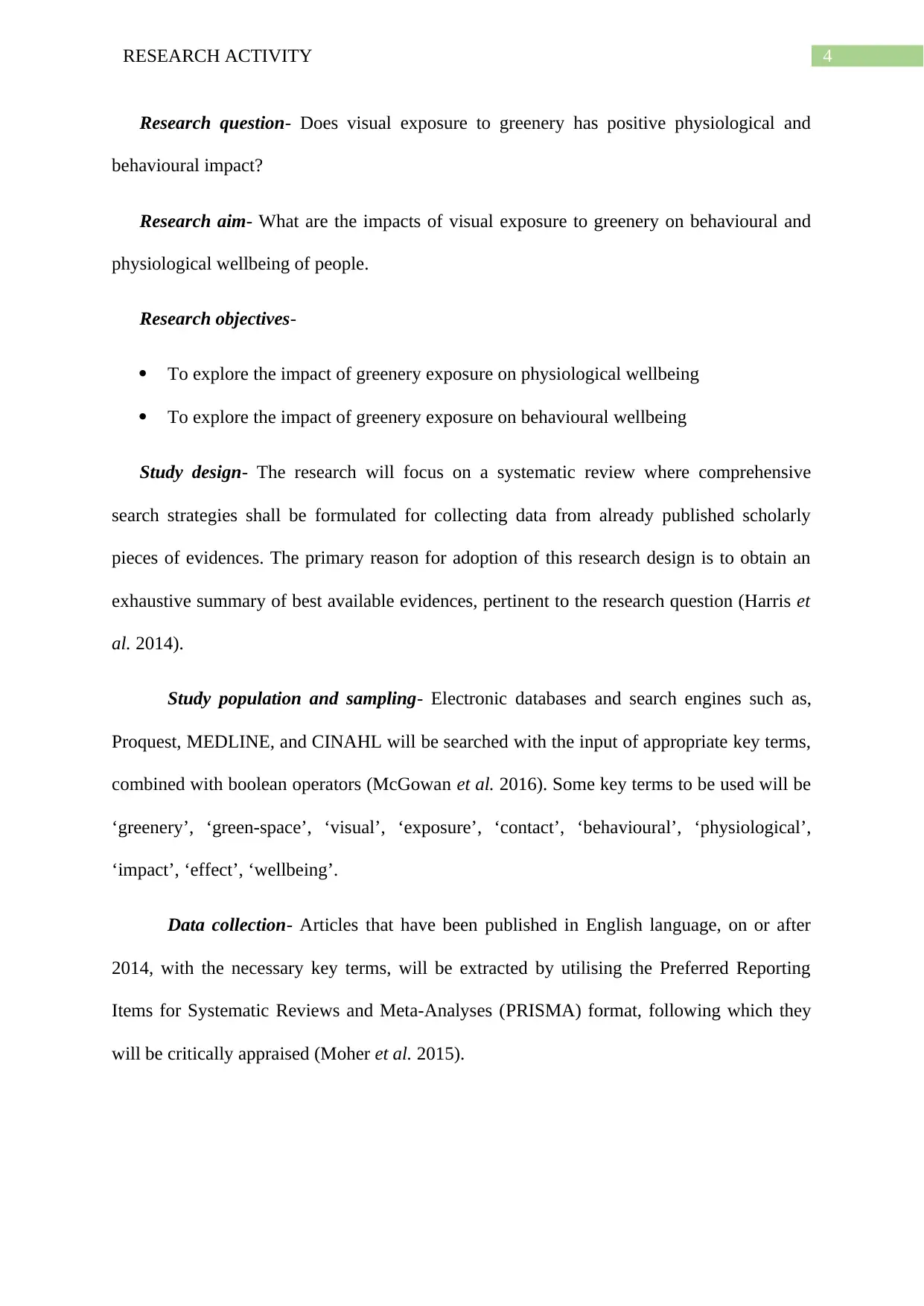
4RESEARCH ACTIVITY
Research question- Does visual exposure to greenery has positive physiological and
behavioural impact?
Research aim- What are the impacts of visual exposure to greenery on behavioural and
physiological wellbeing of people.
Research objectives-
To explore the impact of greenery exposure on physiological wellbeing
To explore the impact of greenery exposure on behavioural wellbeing
Study design- The research will focus on a systematic review where comprehensive
search strategies shall be formulated for collecting data from already published scholarly
pieces of evidences. The primary reason for adoption of this research design is to obtain an
exhaustive summary of best available evidences, pertinent to the research question (Harris et
al. 2014).
Study population and sampling- Electronic databases and search engines such as,
Proquest, MEDLINE, and CINAHL will be searched with the input of appropriate key terms,
combined with boolean operators (McGowan et al. 2016). Some key terms to be used will be
‘greenery’, ‘green-space’, ‘visual’, ‘exposure’, ‘contact’, ‘behavioural’, ‘physiological’,
‘impact’, ‘effect’, ‘wellbeing’.
Data collection- Articles that have been published in English language, on or after
2014, with the necessary key terms, will be extracted by utilising the Preferred Reporting
Items for Systematic Reviews and Meta-Analyses (PRISMA) format, following which they
will be critically appraised (Moher et al. 2015).
Research question- Does visual exposure to greenery has positive physiological and
behavioural impact?
Research aim- What are the impacts of visual exposure to greenery on behavioural and
physiological wellbeing of people.
Research objectives-
To explore the impact of greenery exposure on physiological wellbeing
To explore the impact of greenery exposure on behavioural wellbeing
Study design- The research will focus on a systematic review where comprehensive
search strategies shall be formulated for collecting data from already published scholarly
pieces of evidences. The primary reason for adoption of this research design is to obtain an
exhaustive summary of best available evidences, pertinent to the research question (Harris et
al. 2014).
Study population and sampling- Electronic databases and search engines such as,
Proquest, MEDLINE, and CINAHL will be searched with the input of appropriate key terms,
combined with boolean operators (McGowan et al. 2016). Some key terms to be used will be
‘greenery’, ‘green-space’, ‘visual’, ‘exposure’, ‘contact’, ‘behavioural’, ‘physiological’,
‘impact’, ‘effect’, ‘wellbeing’.
Data collection- Articles that have been published in English language, on or after
2014, with the necessary key terms, will be extracted by utilising the Preferred Reporting
Items for Systematic Reviews and Meta-Analyses (PRISMA) format, following which they
will be critically appraised (Moher et al. 2015).

5RESEARCH ACTIVITY
Data analysis- Specific patterns and information from the extracted articles will be
examined, pinpointed, and recorded in the form of themes, for describing the phenomenon
under investigation (Braun et al. 2019).
Ethical considerations- Duplicate and redundant publications shall be avoided.
Efforts will also be taken to refrain from plagiarising the words, data and original creations of
the authors, whose published articles will be selected. Articles that have conflicts of interest
between the researchers will not be selected for the review.
Data analysis- Specific patterns and information from the extracted articles will be
examined, pinpointed, and recorded in the form of themes, for describing the phenomenon
under investigation (Braun et al. 2019).
Ethical considerations- Duplicate and redundant publications shall be avoided.
Efforts will also be taken to refrain from plagiarising the words, data and original creations of
the authors, whose published articles will be selected. Articles that have conflicts of interest
between the researchers will not be selected for the review.
⊘ This is a preview!⊘
Do you want full access?
Subscribe today to unlock all pages.

Trusted by 1+ million students worldwide
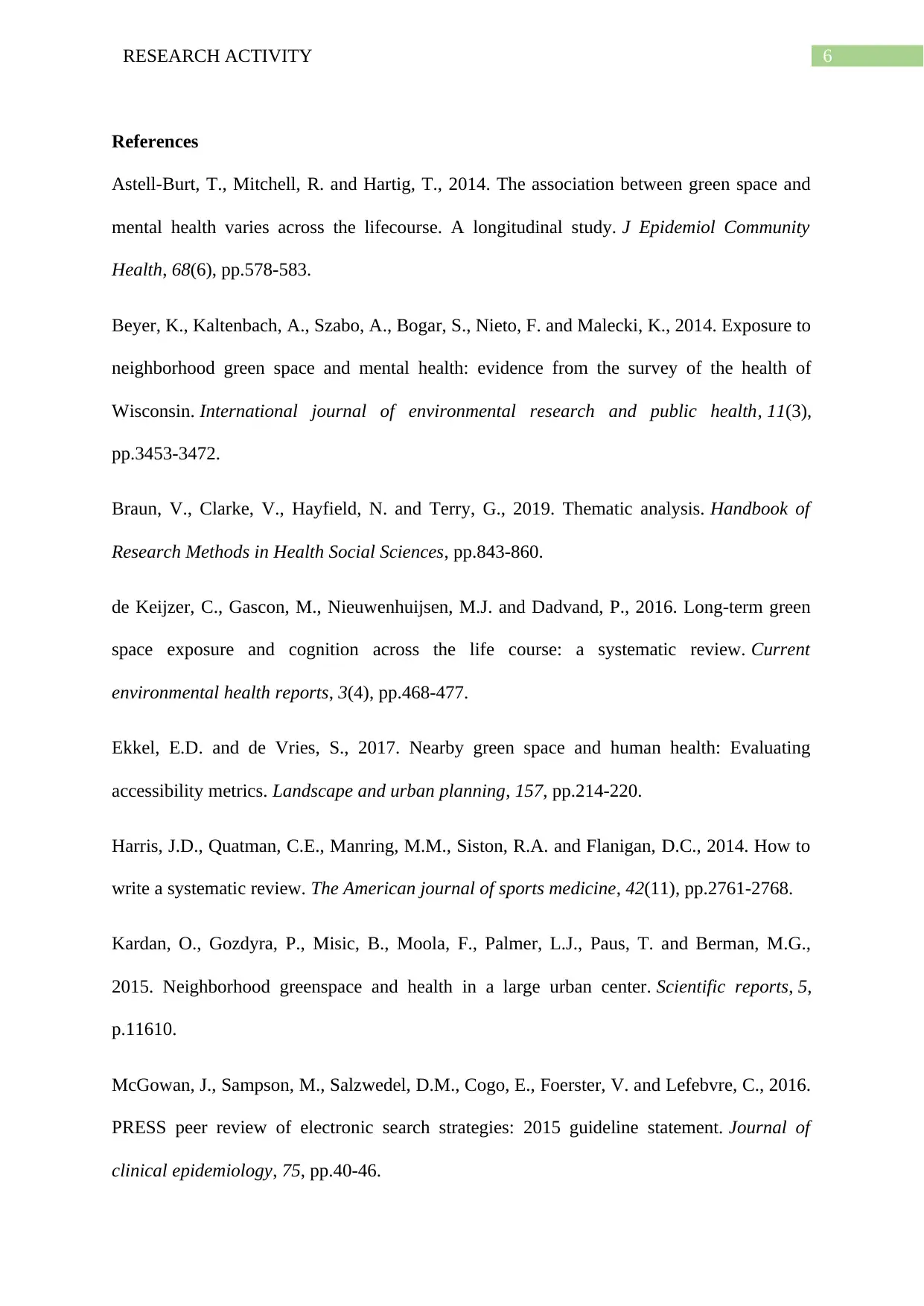
6RESEARCH ACTIVITY
References
Astell-Burt, T., Mitchell, R. and Hartig, T., 2014. The association between green space and
mental health varies across the lifecourse. A longitudinal study. J Epidemiol Community
Health, 68(6), pp.578-583.
Beyer, K., Kaltenbach, A., Szabo, A., Bogar, S., Nieto, F. and Malecki, K., 2014. Exposure to
neighborhood green space and mental health: evidence from the survey of the health of
Wisconsin. International journal of environmental research and public health, 11(3),
pp.3453-3472.
Braun, V., Clarke, V., Hayfield, N. and Terry, G., 2019. Thematic analysis. Handbook of
Research Methods in Health Social Sciences, pp.843-860.
de Keijzer, C., Gascon, M., Nieuwenhuijsen, M.J. and Dadvand, P., 2016. Long-term green
space exposure and cognition across the life course: a systematic review. Current
environmental health reports, 3(4), pp.468-477.
Ekkel, E.D. and de Vries, S., 2017. Nearby green space and human health: Evaluating
accessibility metrics. Landscape and urban planning, 157, pp.214-220.
Harris, J.D., Quatman, C.E., Manring, M.M., Siston, R.A. and Flanigan, D.C., 2014. How to
write a systematic review. The American journal of sports medicine, 42(11), pp.2761-2768.
Kardan, O., Gozdyra, P., Misic, B., Moola, F., Palmer, L.J., Paus, T. and Berman, M.G.,
2015. Neighborhood greenspace and health in a large urban center. Scientific reports, 5,
p.11610.
McGowan, J., Sampson, M., Salzwedel, D.M., Cogo, E., Foerster, V. and Lefebvre, C., 2016.
PRESS peer review of electronic search strategies: 2015 guideline statement. Journal of
clinical epidemiology, 75, pp.40-46.
References
Astell-Burt, T., Mitchell, R. and Hartig, T., 2014. The association between green space and
mental health varies across the lifecourse. A longitudinal study. J Epidemiol Community
Health, 68(6), pp.578-583.
Beyer, K., Kaltenbach, A., Szabo, A., Bogar, S., Nieto, F. and Malecki, K., 2014. Exposure to
neighborhood green space and mental health: evidence from the survey of the health of
Wisconsin. International journal of environmental research and public health, 11(3),
pp.3453-3472.
Braun, V., Clarke, V., Hayfield, N. and Terry, G., 2019. Thematic analysis. Handbook of
Research Methods in Health Social Sciences, pp.843-860.
de Keijzer, C., Gascon, M., Nieuwenhuijsen, M.J. and Dadvand, P., 2016. Long-term green
space exposure and cognition across the life course: a systematic review. Current
environmental health reports, 3(4), pp.468-477.
Ekkel, E.D. and de Vries, S., 2017. Nearby green space and human health: Evaluating
accessibility metrics. Landscape and urban planning, 157, pp.214-220.
Harris, J.D., Quatman, C.E., Manring, M.M., Siston, R.A. and Flanigan, D.C., 2014. How to
write a systematic review. The American journal of sports medicine, 42(11), pp.2761-2768.
Kardan, O., Gozdyra, P., Misic, B., Moola, F., Palmer, L.J., Paus, T. and Berman, M.G.,
2015. Neighborhood greenspace and health in a large urban center. Scientific reports, 5,
p.11610.
McGowan, J., Sampson, M., Salzwedel, D.M., Cogo, E., Foerster, V. and Lefebvre, C., 2016.
PRESS peer review of electronic search strategies: 2015 guideline statement. Journal of
clinical epidemiology, 75, pp.40-46.
Paraphrase This Document
Need a fresh take? Get an instant paraphrase of this document with our AI Paraphraser

7RESEARCH ACTIVITY
Moher, D., Shamseer, L., Clarke, M., Ghersi, D., Liberati, A., Petticrew, M., Shekelle, P. and
Stewart, L.A., 2015. Preferred reporting items for systematic review and meta-analysis
protocols (PRISMA-P) 2015 statement. Systematic reviews, 4(1), p.1.
Wolch, J.R., Byrne, J. and Newell, J.P., 2014. Urban green space, public health, and
environmental justice: The challenge of making cities ‘just green enough’. Landscape and
urban planning, 125, pp.234-244.
Moher, D., Shamseer, L., Clarke, M., Ghersi, D., Liberati, A., Petticrew, M., Shekelle, P. and
Stewart, L.A., 2015. Preferred reporting items for systematic review and meta-analysis
protocols (PRISMA-P) 2015 statement. Systematic reviews, 4(1), p.1.
Wolch, J.R., Byrne, J. and Newell, J.P., 2014. Urban green space, public health, and
environmental justice: The challenge of making cities ‘just green enough’. Landscape and
urban planning, 125, pp.234-244.
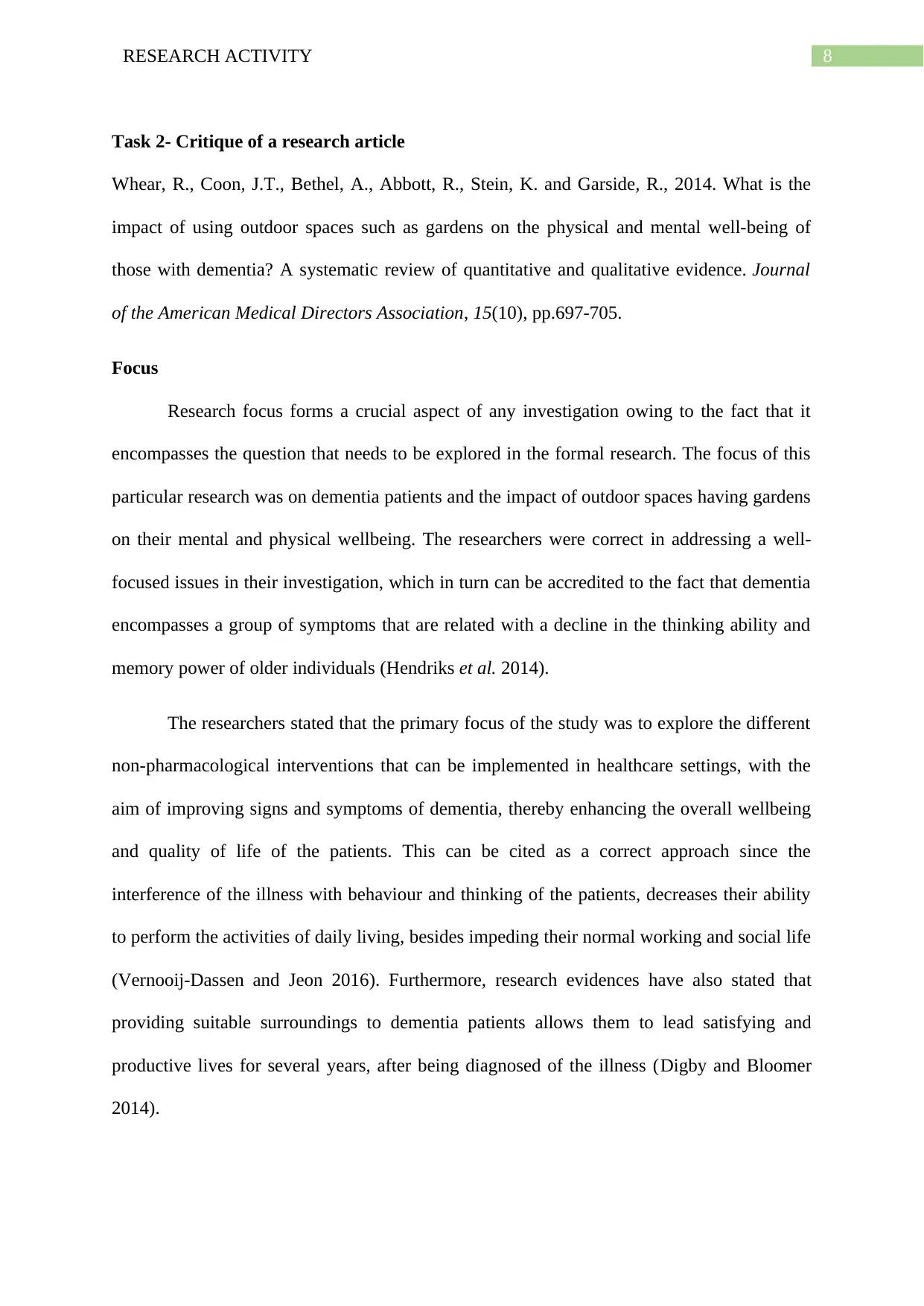
8RESEARCH ACTIVITY
Task 2- Critique of a research article
Whear, R., Coon, J.T., Bethel, A., Abbott, R., Stein, K. and Garside, R., 2014. What is the
impact of using outdoor spaces such as gardens on the physical and mental well-being of
those with dementia? A systematic review of quantitative and qualitative evidence. Journal
of the American Medical Directors Association, 15(10), pp.697-705.
Focus
Research focus forms a crucial aspect of any investigation owing to the fact that it
encompasses the question that needs to be explored in the formal research. The focus of this
particular research was on dementia patients and the impact of outdoor spaces having gardens
on their mental and physical wellbeing. The researchers were correct in addressing a well-
focused issues in their investigation, which in turn can be accredited to the fact that dementia
encompasses a group of symptoms that are related with a decline in the thinking ability and
memory power of older individuals (Hendriks et al. 2014).
The researchers stated that the primary focus of the study was to explore the different
non-pharmacological interventions that can be implemented in healthcare settings, with the
aim of improving signs and symptoms of dementia, thereby enhancing the overall wellbeing
and quality of life of the patients. This can be cited as a correct approach since the
interference of the illness with behaviour and thinking of the patients, decreases their ability
to perform the activities of daily living, besides impeding their normal working and social life
(Vernooij-Dassen and Jeon 2016). Furthermore, research evidences have also stated that
providing suitable surroundings to dementia patients allows them to lead satisfying and
productive lives for several years, after being diagnosed of the illness (Digby and Bloomer
2014).
Task 2- Critique of a research article
Whear, R., Coon, J.T., Bethel, A., Abbott, R., Stein, K. and Garside, R., 2014. What is the
impact of using outdoor spaces such as gardens on the physical and mental well-being of
those with dementia? A systematic review of quantitative and qualitative evidence. Journal
of the American Medical Directors Association, 15(10), pp.697-705.
Focus
Research focus forms a crucial aspect of any investigation owing to the fact that it
encompasses the question that needs to be explored in the formal research. The focus of this
particular research was on dementia patients and the impact of outdoor spaces having gardens
on their mental and physical wellbeing. The researchers were correct in addressing a well-
focused issues in their investigation, which in turn can be accredited to the fact that dementia
encompasses a group of symptoms that are related with a decline in the thinking ability and
memory power of older individuals (Hendriks et al. 2014).
The researchers stated that the primary focus of the study was to explore the different
non-pharmacological interventions that can be implemented in healthcare settings, with the
aim of improving signs and symptoms of dementia, thereby enhancing the overall wellbeing
and quality of life of the patients. This can be cited as a correct approach since the
interference of the illness with behaviour and thinking of the patients, decreases their ability
to perform the activities of daily living, besides impeding their normal working and social life
(Vernooij-Dassen and Jeon 2016). Furthermore, research evidences have also stated that
providing suitable surroundings to dementia patients allows them to lead satisfying and
productive lives for several years, after being diagnosed of the illness (Digby and Bloomer
2014).
⊘ This is a preview!⊘
Do you want full access?
Subscribe today to unlock all pages.

Trusted by 1+ million students worldwide
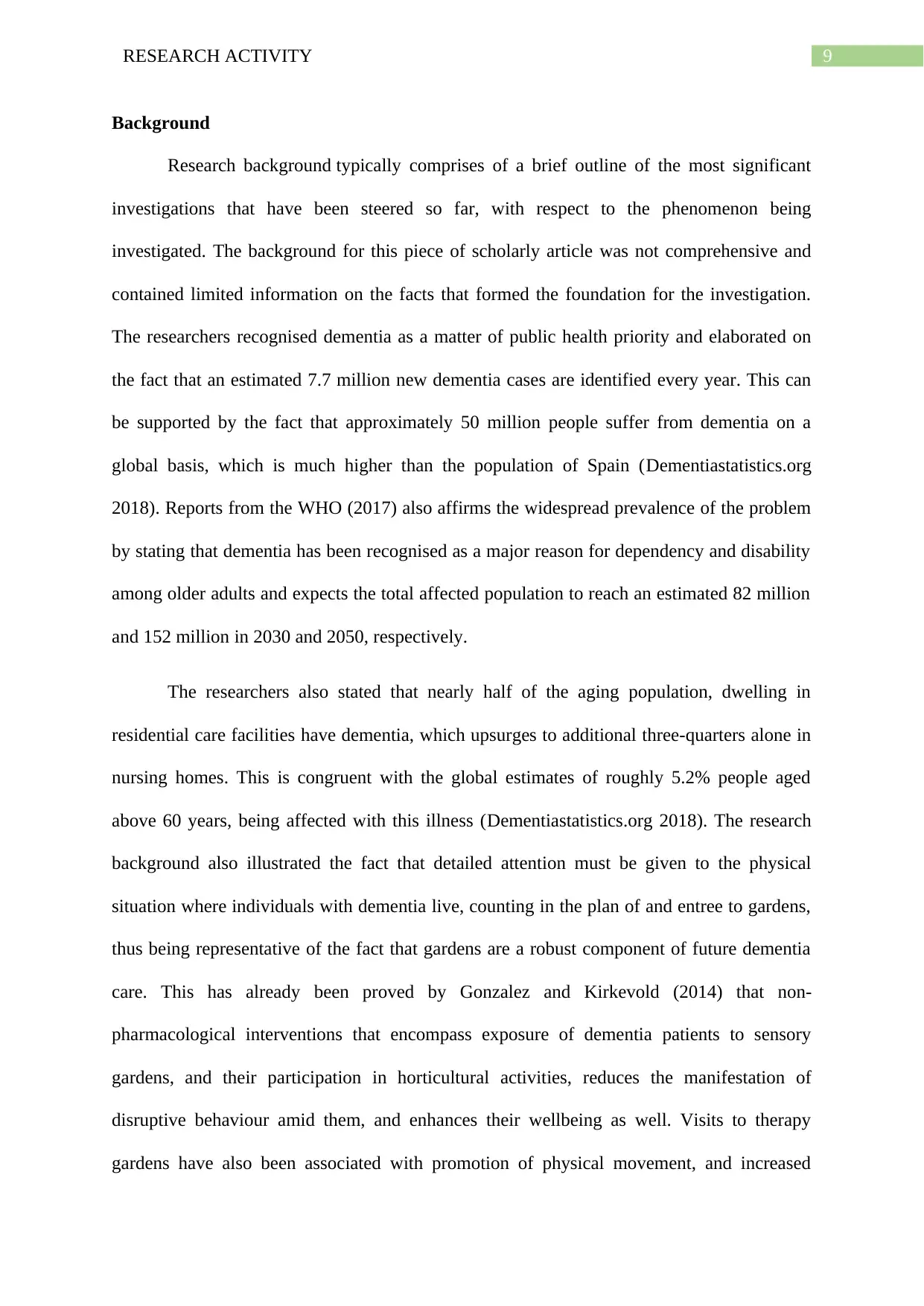
9RESEARCH ACTIVITY
Background
Research background typically comprises of a brief outline of the most significant
investigations that have been steered so far, with respect to the phenomenon being
investigated. The background for this piece of scholarly article was not comprehensive and
contained limited information on the facts that formed the foundation for the investigation.
The researchers recognised dementia as a matter of public health priority and elaborated on
the fact that an estimated 7.7 million new dementia cases are identified every year. This can
be supported by the fact that approximately 50 million people suffer from dementia on a
global basis, which is much higher than the population of Spain (Dementiastatistics.org
2018). Reports from the WHO (2017) also affirms the widespread prevalence of the problem
by stating that dementia has been recognised as a major reason for dependency and disability
among older adults and expects the total affected population to reach an estimated 82 million
and 152 million in 2030 and 2050, respectively.
The researchers also stated that nearly half of the aging population, dwelling in
residential care facilities have dementia, which upsurges to additional three-quarters alone in
nursing homes. This is congruent with the global estimates of roughly 5.2% people aged
above 60 years, being affected with this illness (Dementiastatistics.org 2018). The research
background also illustrated the fact that detailed attention must be given to the physical
situation where individuals with dementia live, counting in the plan of and entree to gardens,
thus being representative of the fact that gardens are a robust component of future dementia
care. This has already been proved by Gonzalez and Kirkevold (2014) that non-
pharmacological interventions that encompass exposure of dementia patients to sensory
gardens, and their participation in horticultural activities, reduces the manifestation of
disruptive behaviour amid them, and enhances their wellbeing as well. Visits to therapy
gardens have also been associated with promotion of physical movement, and increased
Background
Research background typically comprises of a brief outline of the most significant
investigations that have been steered so far, with respect to the phenomenon being
investigated. The background for this piece of scholarly article was not comprehensive and
contained limited information on the facts that formed the foundation for the investigation.
The researchers recognised dementia as a matter of public health priority and elaborated on
the fact that an estimated 7.7 million new dementia cases are identified every year. This can
be supported by the fact that approximately 50 million people suffer from dementia on a
global basis, which is much higher than the population of Spain (Dementiastatistics.org
2018). Reports from the WHO (2017) also affirms the widespread prevalence of the problem
by stating that dementia has been recognised as a major reason for dependency and disability
among older adults and expects the total affected population to reach an estimated 82 million
and 152 million in 2030 and 2050, respectively.
The researchers also stated that nearly half of the aging population, dwelling in
residential care facilities have dementia, which upsurges to additional three-quarters alone in
nursing homes. This is congruent with the global estimates of roughly 5.2% people aged
above 60 years, being affected with this illness (Dementiastatistics.org 2018). The research
background also illustrated the fact that detailed attention must be given to the physical
situation where individuals with dementia live, counting in the plan of and entree to gardens,
thus being representative of the fact that gardens are a robust component of future dementia
care. This has already been proved by Gonzalez and Kirkevold (2014) that non-
pharmacological interventions that encompass exposure of dementia patients to sensory
gardens, and their participation in horticultural activities, reduces the manifestation of
disruptive behaviour amid them, and enhances their wellbeing as well. Visits to therapy
gardens have also been associated with promotion of physical movement, and increased
Paraphrase This Document
Need a fresh take? Get an instant paraphrase of this document with our AI Paraphraser
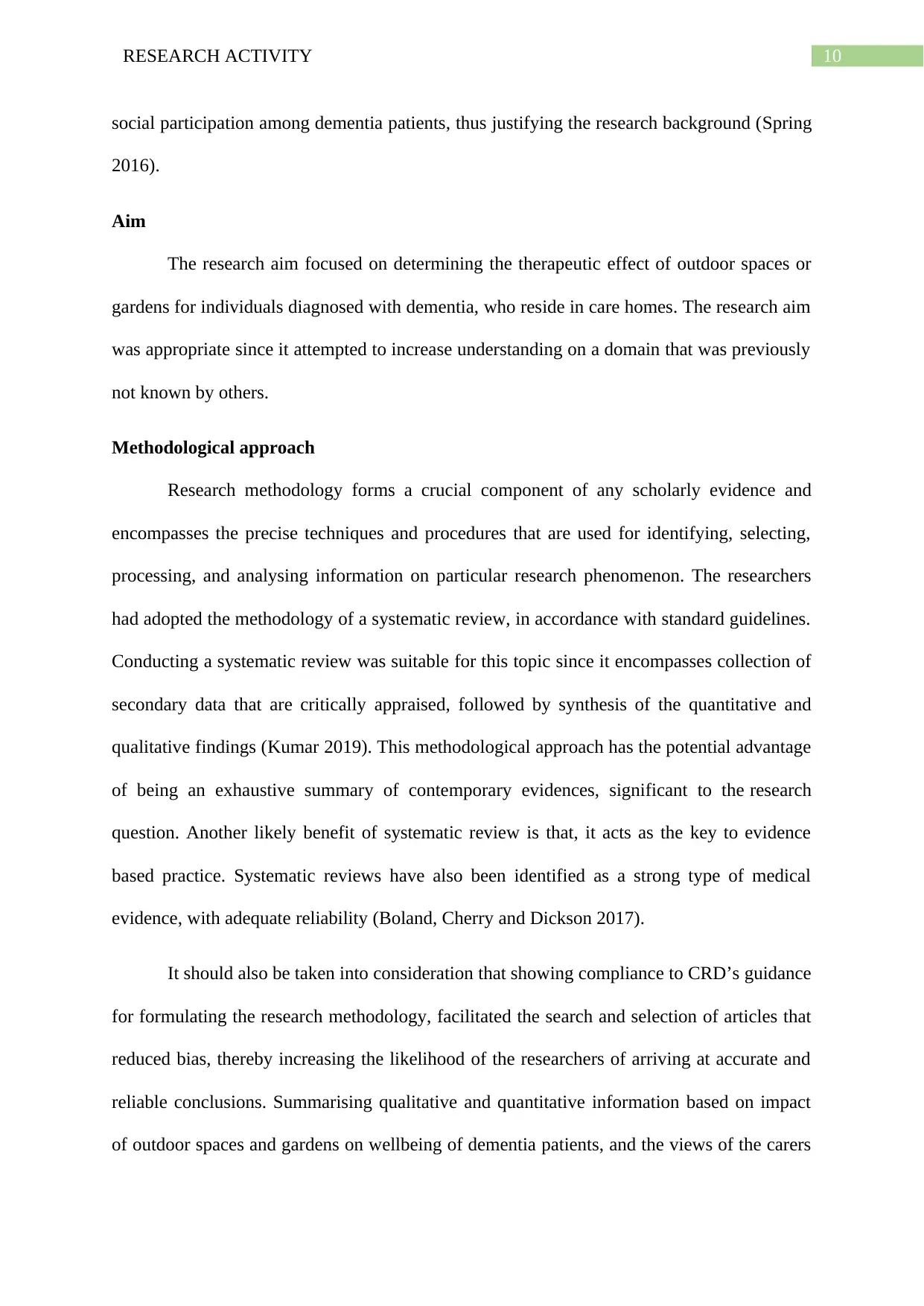
10RESEARCH ACTIVITY
social participation among dementia patients, thus justifying the research background (Spring
2016).
Aim
The research aim focused on determining the therapeutic effect of outdoor spaces or
gardens for individuals diagnosed with dementia, who reside in care homes. The research aim
was appropriate since it attempted to increase understanding on a domain that was previously
not known by others.
Methodological approach
Research methodology forms a crucial component of any scholarly evidence and
encompasses the precise techniques and procedures that are used for identifying, selecting,
processing, and analysing information on particular research phenomenon. The researchers
had adopted the methodology of a systematic review, in accordance with standard guidelines.
Conducting a systematic review was suitable for this topic since it encompasses collection of
secondary data that are critically appraised, followed by synthesis of the quantitative and
qualitative findings (Kumar 2019). This methodological approach has the potential advantage
of being an exhaustive summary of contemporary evidences, significant to the research
question. Another likely benefit of systematic review is that, it acts as the key to evidence
based practice. Systematic reviews have also been identified as a strong type of medical
evidence, with adequate reliability (Boland, Cherry and Dickson 2017).
It should also be taken into consideration that showing compliance to CRD’s guidance
for formulating the research methodology, facilitated the search and selection of articles that
reduced bias, thereby increasing the likelihood of the researchers of arriving at accurate and
reliable conclusions. Summarising qualitative and quantitative information based on impact
of outdoor spaces and gardens on wellbeing of dementia patients, and the views of the carers
social participation among dementia patients, thus justifying the research background (Spring
2016).
Aim
The research aim focused on determining the therapeutic effect of outdoor spaces or
gardens for individuals diagnosed with dementia, who reside in care homes. The research aim
was appropriate since it attempted to increase understanding on a domain that was previously
not known by others.
Methodological approach
Research methodology forms a crucial component of any scholarly evidence and
encompasses the precise techniques and procedures that are used for identifying, selecting,
processing, and analysing information on particular research phenomenon. The researchers
had adopted the methodology of a systematic review, in accordance with standard guidelines.
Conducting a systematic review was suitable for this topic since it encompasses collection of
secondary data that are critically appraised, followed by synthesis of the quantitative and
qualitative findings (Kumar 2019). This methodological approach has the potential advantage
of being an exhaustive summary of contemporary evidences, significant to the research
question. Another likely benefit of systematic review is that, it acts as the key to evidence
based practice. Systematic reviews have also been identified as a strong type of medical
evidence, with adequate reliability (Boland, Cherry and Dickson 2017).
It should also be taken into consideration that showing compliance to CRD’s guidance
for formulating the research methodology, facilitated the search and selection of articles that
reduced bias, thereby increasing the likelihood of the researchers of arriving at accurate and
reliable conclusions. Summarising qualitative and quantitative information based on impact
of outdoor spaces and gardens on wellbeing of dementia patients, and the views of the carers
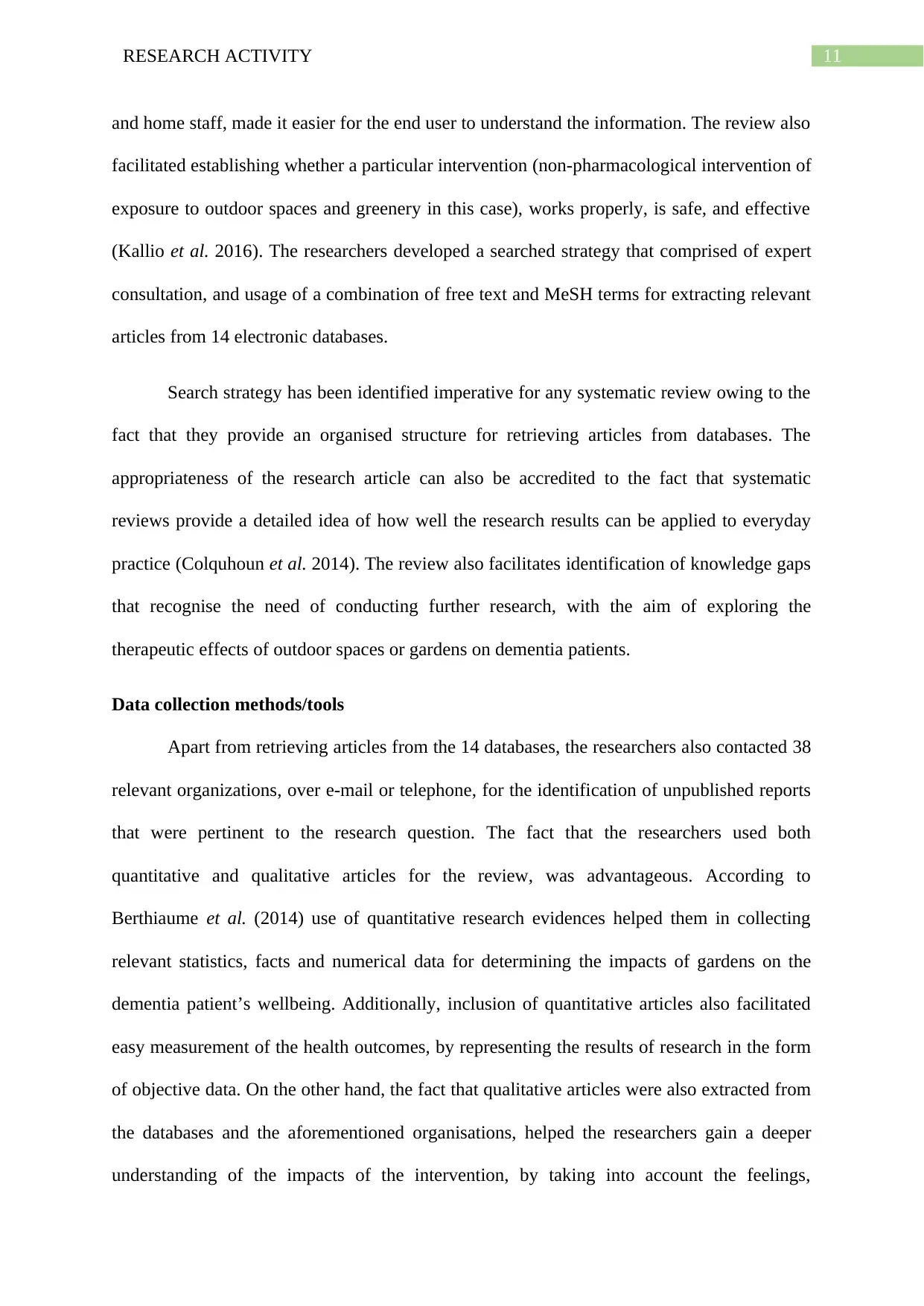
11RESEARCH ACTIVITY
and home staff, made it easier for the end user to understand the information. The review also
facilitated establishing whether a particular intervention (non-pharmacological intervention of
exposure to outdoor spaces and greenery in this case), works properly, is safe, and effective
(Kallio et al. 2016). The researchers developed a searched strategy that comprised of expert
consultation, and usage of a combination of free text and MeSH terms for extracting relevant
articles from 14 electronic databases.
Search strategy has been identified imperative for any systematic review owing to the
fact that they provide an organised structure for retrieving articles from databases. The
appropriateness of the research article can also be accredited to the fact that systematic
reviews provide a detailed idea of how well the research results can be applied to everyday
practice (Colquhoun et al. 2014). The review also facilitates identification of knowledge gaps
that recognise the need of conducting further research, with the aim of exploring the
therapeutic effects of outdoor spaces or gardens on dementia patients.
Data collection methods/tools
Apart from retrieving articles from the 14 databases, the researchers also contacted 38
relevant organizations, over e-mail or telephone, for the identification of unpublished reports
that were pertinent to the research question. The fact that the researchers used both
quantitative and qualitative articles for the review, was advantageous. According to
Berthiaume et al. (2014) use of quantitative research evidences helped them in collecting
relevant statistics, facts and numerical data for determining the impacts of gardens on the
dementia patient’s wellbeing. Additionally, inclusion of quantitative articles also facilitated
easy measurement of the health outcomes, by representing the results of research in the form
of objective data. On the other hand, the fact that qualitative articles were also extracted from
the databases and the aforementioned organisations, helped the researchers gain a deeper
understanding of the impacts of the intervention, by taking into account the feelings,
and home staff, made it easier for the end user to understand the information. The review also
facilitated establishing whether a particular intervention (non-pharmacological intervention of
exposure to outdoor spaces and greenery in this case), works properly, is safe, and effective
(Kallio et al. 2016). The researchers developed a searched strategy that comprised of expert
consultation, and usage of a combination of free text and MeSH terms for extracting relevant
articles from 14 electronic databases.
Search strategy has been identified imperative for any systematic review owing to the
fact that they provide an organised structure for retrieving articles from databases. The
appropriateness of the research article can also be accredited to the fact that systematic
reviews provide a detailed idea of how well the research results can be applied to everyday
practice (Colquhoun et al. 2014). The review also facilitates identification of knowledge gaps
that recognise the need of conducting further research, with the aim of exploring the
therapeutic effects of outdoor spaces or gardens on dementia patients.
Data collection methods/tools
Apart from retrieving articles from the 14 databases, the researchers also contacted 38
relevant organizations, over e-mail or telephone, for the identification of unpublished reports
that were pertinent to the research question. The fact that the researchers used both
quantitative and qualitative articles for the review, was advantageous. According to
Berthiaume et al. (2014) use of quantitative research evidences helped them in collecting
relevant statistics, facts and numerical data for determining the impacts of gardens on the
dementia patient’s wellbeing. Additionally, inclusion of quantitative articles also facilitated
easy measurement of the health outcomes, by representing the results of research in the form
of objective data. On the other hand, the fact that qualitative articles were also extracted from
the databases and the aforementioned organisations, helped the researchers gain a deeper
understanding of the impacts of the intervention, by taking into account the feelings,
⊘ This is a preview!⊘
Do you want full access?
Subscribe today to unlock all pages.

Trusted by 1+ million students worldwide
1 out of 20
Your All-in-One AI-Powered Toolkit for Academic Success.
+13062052269
info@desklib.com
Available 24*7 on WhatsApp / Email
![[object Object]](/_next/static/media/star-bottom.7253800d.svg)
Unlock your academic potential
Copyright © 2020–2025 A2Z Services. All Rights Reserved. Developed and managed by ZUCOL.

